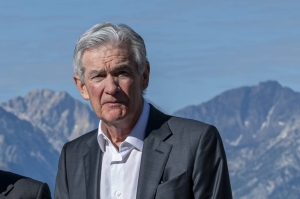Fed adopts gradualism, a familiar policy for uncertain times


Jerome Powell, chairman of the US Federal Reserve.
A handful of policymakers at the Fed’s annual research symposium in Jackson Hole, Wyoming, last week made the case for lowering rates in a “gradual” or “methodical” manner. That pushed back against investor expectations for at least one outsized cut this fall.
Inflation hasn’t yet fully cooled to their 2% target, the Fed officials argued, and while the labour market shows signs of fragility, the absence of widespread layoffs means aggressive action isn’t yet called for.
“Methodical, gradual, careful — those are the types of words you hear policymakers throw around when they’re turning the ship,” said Brett Ryan, senior US economist at Deutsche Bank AG. “It’s going to be sort of a feeling-out process that they’re going to want to take a slower approach on.”
Gradualism is a strategy that the Fed has deployed before in uncertain times. It suggests they hope to cut rates by 25 basis points at a time. Yet notably absent from the chorus backing this approach was Chair Jerome Powell.
The Fed chief has staked his legacy on bringing down inflation without causing severe pain in the job market. In his closely watched speech in Jackson Hole, Powell never described how quickly or slowly he expects the Fed to move after September. He also sounded more open than several of his colleagues to taking a more aggressive approach should things deteriorate rapidly on the employment front.
“We will do everything we can to support a strong labour market as we make further progress toward price stability,” Powell said. “We do not seek or welcome further cooling in labour market conditions.”
The Fed, like many other central banks, has taken a gradual approach during most easing and tightening cycles in the modern era, with a few exceptions.
At the onset of the financial crisis and during the Covid pandemic, policymakers rapidly drove interest rates to zero. Former Chair Paul Volcker was famously unflinching in his strategy for quashing inflation in the late 1970s and early 1980s. Otherwise, monetary policy has more typically been adjusted by just a quarter percentage point at a time.
This approach, as detailed by then-Governor Ben Bernanke in a 2004 speech on gradualism, gives policymakers time to gauge the economy’s response to its actions.
Applied now, gradualism would provide some relief from the Fed’s current level of restrictiveness, but also take into account that the inflation target hasn’t yet been achieved. After underestimating the surge in prices in 2021 and starting to tighten too late, some policymakers are still wary of reigniting inflation. At least one worries that cheaper borrowing costs will release pent-up demand from consumers and businesses awaiting lower rates.
But at the same time, the labour market is finally beginning to look normal again, and by some measures a bit weak. Unemployment unexpectedly rose to 4.3% in July. Employers aren’t firing workers en masse, but they’ve slowed hiring dramatically.
To some, like Richmond Fed President Thomas Barkin, that’s a combination that is unlikely to continue for long.
“They have a significant question around them now in terms of labour market weakening,” said Claudia Sahm, chief economist at New Century Advisors, an investment management firm. “They need to start removing the restriction.”
Powell and his colleagues long argued the hot jobs market was stoking inflation by driving wages higher and giving US consumers more spending power. But Powell made clear that effect has faded.
“Powell appears to be more dovish than his peers,” said EY-Parthenon economists Gregory Daco and Lydia Boussour. “Still, unless labour conditions deteriorate materially in the coming weeks, we continue to expect a majority of policymakers will favour a 25 basis-point cut in September.”
As Fed officials embark on this next phase, they face another question besides how fast to go: If all goes smoothly, how far can they eventually cut rates?
The so-called neutral rate of interest, where the central bank is neither holding down the economy nor stimulating it, is an estimate rather than an exact scientific calculation. Some Fed officials and economists argue that in the post-pandemic economy, where labour productivity is up, that level may be higher than it once was.
Given the uncertainty, that makes moving gradually all the more attractive.
If officials could somehow know with confidence where the neutral rate lay, said Barkin, they could just move there and declare victory. But it’s not that simple in real life.
“You sort of want to feel your way there,” he said in an episode of Bloomberg’s Odd Lots podcast recorded last week. “You’ll learn based on whether inflation has settled or is accelerating. You’ll learn based on whether the labour market is growing or shrinking. You’ll learn those things as you go and you’ll adjust rates as appropriate.”
Others at the Fed, like San Francisco’s Mary Daly, think it’s too early to worry about neutral.
“The really relevant thing now is that even when we make adjustments to the policy rate to make sure it’s right, we will still be in restrictive territory,” she said in an interview on Bloomberg Television. “We have a long ways to go.”



